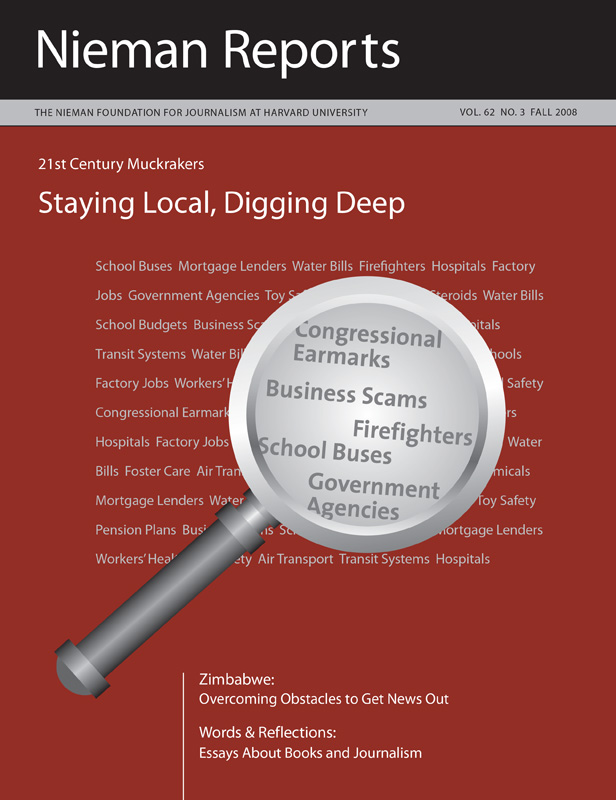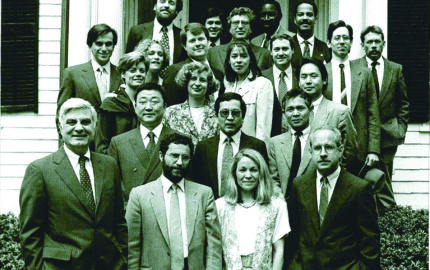Sorting through boxes and folders of Nieman history has occupied us this summer as we prepare for the foundation’s 70th Anniversary Convocation this fall. It is a fascinating exercise, rediscovering long-forgotten anecdotes, reviewing critical moments in the life of the program, and getting a fresh perspective of what it has been like to be a Nieman Fellow through the years.
Nearly 20 years ago, in the spring of 1989, the foundation prepared to celebrate its 50th birthday, and Howard Simons, the curator, wrote in Nieman Reports that he “was struck by the fact that the core program has not changed in 50 years .… It is a tribute to belief in the bromide, ‘If it ain’t broke, don’t fix it.’”
Curators have been mindful of the imperative to continue the fellowship program as hundreds of fellows have experienced it—and about which they often speak with great affection. But they also have recognized that promoting and elevating the standards of journalism—the foundation’s mission—has meant expanding its role from time to time to confront the challenges brought about by societal and technological changes that affect journalism.
The first significant expansion of the foundation’s role came in the founding of Nieman Reports in 1947. The report of the Hutchins Commission on A Free and Responsible Press, published that year, deplored the absence of a forum for regular and serious criticism of the press. This inspired Louis M. Lyons, the curator, and the class to establish Nieman Reports “as a medium for discussion, appraisal and criticism of professional newspapering.” Today, under Editor Melissa Ludtke, a 1992 Nieman Fellow, its content speaks to topics far broader than its original mandate.
International fellowships were the next enlargement of the program in 1951. Lyons was eager to bring a global perspective to the program and wanted to support international journalists in strengthening their independent voices as a result of their Harvard experience.
Writing has been a subject of keen interest to Nieman Fellows since the very early years of the program, when they found an outlet in an English seminar taught by Theodore Morrison. After Morrison retired, the foundation began to offer writing instruction with Diana Thomson, the wife of Curator Jim Thomson. In more recent years, Nieman Fellows have studied and practiced the literary form under the tutelage of Anne Bernays and Rose Moss. In 1999, in response to increasing interest from fellows, the foundation expanded its writing program to include narrative nonfiction, taught first by Robert Vare, a 1997 Nieman Fellow, and then Mark Kramer. An outgrowth of the narrative class is the annual narrative journalism conference and the online Nieman Narrative Digest, now directed by Constance Hale.
A generous gift in the mid-1990’s from Murrey Marder, a 1950 Nieman Fellow, encouraged greater engagement with watchdog journalism, an idea that led to the Nieman Watchdog Web site, edited by Barry Sussman, which helps members of the press to ask probing questions.
Recently, Nieman Fellows have expressed anxiety about how the emerging digital technology is affecting the practice of journalism. In an attempt to alleviate some of their uncertainty, the foundation is offering a series of workshops throughout the year that will focus on learning how to take advantage of opportunities presented by these new tools of journalism. At the same time, the foundation saw a need to establish its own presence in this time of transformation. After much discussion and deliberation, the Nieman Journalism Lab was established this summer with Joshua Benton, a 2008 Nieman Fellow, as its editor. Its Web site, www.niemanlab.org, will be launched this fall as a resource for learning about best new practices that support quality journalism.
In our early years, Nieman classes were populated exclusively by newspaper journalists. As television and, later, public radio came of age, broadcast journalists were selected but in far fewer numbers than their print counterparts. In spite of recent efforts we’ve made to encourage networks and cable news organizations to consider the value of midcareer education for their leading journalists, we remain disappointed by the relatively small number of broadcast journalists who apply each year.
Still, Nieman classes have become more diverse in recent years as documentary filmmakers and photojournalists, online journalists and freelance writers have joined their classmates who come from more traditional roles at mainstream news organizations. It is no longer rare for a fellow to be offered a buyout during the year, and this new reality in newsrooms has compelled the foundation to include journalists in transition who use the resources of Harvard to prepare themselves for new directions in their journalism careers.
Enlarging our footprint during these 70 years attests to the desire of curators and fellows to find ways to respond to the evolving challenges of improving and sustaining the craft of journalism. Yet, in thinking about the Harvard experience of fellows in 1938 and 2008, the fellowship’s core idea of enabling a year of study at Harvard for working journalists has not changed.
Nearly 20 years ago, in the spring of 1989, the foundation prepared to celebrate its 50th birthday, and Howard Simons, the curator, wrote in Nieman Reports that he “was struck by the fact that the core program has not changed in 50 years .… It is a tribute to belief in the bromide, ‘If it ain’t broke, don’t fix it.’”
Curators have been mindful of the imperative to continue the fellowship program as hundreds of fellows have experienced it—and about which they often speak with great affection. But they also have recognized that promoting and elevating the standards of journalism—the foundation’s mission—has meant expanding its role from time to time to confront the challenges brought about by societal and technological changes that affect journalism.
The first significant expansion of the foundation’s role came in the founding of Nieman Reports in 1947. The report of the Hutchins Commission on A Free and Responsible Press, published that year, deplored the absence of a forum for regular and serious criticism of the press. This inspired Louis M. Lyons, the curator, and the class to establish Nieman Reports “as a medium for discussion, appraisal and criticism of professional newspapering.” Today, under Editor Melissa Ludtke, a 1992 Nieman Fellow, its content speaks to topics far broader than its original mandate.
International fellowships were the next enlargement of the program in 1951. Lyons was eager to bring a global perspective to the program and wanted to support international journalists in strengthening their independent voices as a result of their Harvard experience.
Writing has been a subject of keen interest to Nieman Fellows since the very early years of the program, when they found an outlet in an English seminar taught by Theodore Morrison. After Morrison retired, the foundation began to offer writing instruction with Diana Thomson, the wife of Curator Jim Thomson. In more recent years, Nieman Fellows have studied and practiced the literary form under the tutelage of Anne Bernays and Rose Moss. In 1999, in response to increasing interest from fellows, the foundation expanded its writing program to include narrative nonfiction, taught first by Robert Vare, a 1997 Nieman Fellow, and then Mark Kramer. An outgrowth of the narrative class is the annual narrative journalism conference and the online Nieman Narrative Digest, now directed by Constance Hale.
A generous gift in the mid-1990’s from Murrey Marder, a 1950 Nieman Fellow, encouraged greater engagement with watchdog journalism, an idea that led to the Nieman Watchdog Web site, edited by Barry Sussman, which helps members of the press to ask probing questions.
Recently, Nieman Fellows have expressed anxiety about how the emerging digital technology is affecting the practice of journalism. In an attempt to alleviate some of their uncertainty, the foundation is offering a series of workshops throughout the year that will focus on learning how to take advantage of opportunities presented by these new tools of journalism. At the same time, the foundation saw a need to establish its own presence in this time of transformation. After much discussion and deliberation, the Nieman Journalism Lab was established this summer with Joshua Benton, a 2008 Nieman Fellow, as its editor. Its Web site, www.niemanlab.org, will be launched this fall as a resource for learning about best new practices that support quality journalism.
In our early years, Nieman classes were populated exclusively by newspaper journalists. As television and, later, public radio came of age, broadcast journalists were selected but in far fewer numbers than their print counterparts. In spite of recent efforts we’ve made to encourage networks and cable news organizations to consider the value of midcareer education for their leading journalists, we remain disappointed by the relatively small number of broadcast journalists who apply each year.
Still, Nieman classes have become more diverse in recent years as documentary filmmakers and photojournalists, online journalists and freelance writers have joined their classmates who come from more traditional roles at mainstream news organizations. It is no longer rare for a fellow to be offered a buyout during the year, and this new reality in newsrooms has compelled the foundation to include journalists in transition who use the resources of Harvard to prepare themselves for new directions in their journalism careers.
Enlarging our footprint during these 70 years attests to the desire of curators and fellows to find ways to respond to the evolving challenges of improving and sustaining the craft of journalism. Yet, in thinking about the Harvard experience of fellows in 1938 and 2008, the fellowship’s core idea of enabling a year of study at Harvard for working journalists has not changed.



